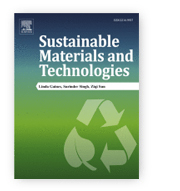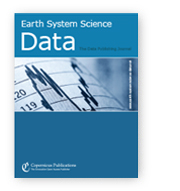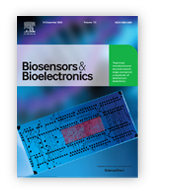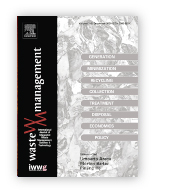
Research papers of the month
We present the highest-scored research papers of November.
Daria Marczak, Krzysztof Lejcuś, Joanna Grzybowska-Pietras, Włodzimierz Biniaś, Iwona Lejcuś, Jakub Misiewicz
Elżbieta Lasota, Andrea K. Steiner, Gottfried Kirchengast, Ricardo Biondi
Aneta Urbanek, Mateusz C. Strzelecki, Aleksandra Mirończuk
Biodegradation of sustainable nonwovens used in water absorbing geocomposites supporting plants vegetation
Daria Marczak, Krzysztof Lejcuś, Joanna Grzybowska-Pietras, Włodzimierz Biniaś, Iwona Lejcuś, Jakub Misiewicz
Sustainable Materials and Technologies
 Due to the growing awareness and the need to reduce the environmental impact of textiles, there is a pressing rationale to use natural materials or fibres in environmental engineering. One solution to achieve energy sustainability is to develop sustainable technologies to gradually replace non-renewable fossil fuels. One of technology is water-absorbing geocomposite (WAG). WAG is an innovative technology that supports water management and the vegetation of plants and is used, among others, in environmental engineering and agriculture. WAG can be produced in biodegradable WAG version, which is also environmentally friendly. The paper provides an evaluation of the influence of time of installation and biodegradation on the mechanical, hydraulic, and chemical properties of used textiles. The biodegradation of geotextiles was analyzed in real time, and their parameters were determined after one vegetation season. Needle-punched nonwovens made from wool and linen or reinforced by jute mesh were biodegraded already after the first vegetation season. Significantly better mechanical properties were observed in nonwovens produced from the same materials, but reinforced by seams. All types of geotextiles were characterised by sufficient resistance to biodegradation that allowed maintaining vegetation and proper operation of WAG at least for one vegetation season. Biodegradable geotextiles installed in soil provide instantaneous protection, and their gradual discomposure fosters plant vegetation.
Due to the growing awareness and the need to reduce the environmental impact of textiles, there is a pressing rationale to use natural materials or fibres in environmental engineering. One solution to achieve energy sustainability is to develop sustainable technologies to gradually replace non-renewable fossil fuels. One of technology is water-absorbing geocomposite (WAG). WAG is an innovative technology that supports water management and the vegetation of plants and is used, among others, in environmental engineering and agriculture. WAG can be produced in biodegradable WAG version, which is also environmentally friendly. The paper provides an evaluation of the influence of time of installation and biodegradation on the mechanical, hydraulic, and chemical properties of used textiles. The biodegradation of geotextiles was analyzed in real time, and their parameters were determined after one vegetation season. Needle-punched nonwovens made from wool and linen or reinforced by jute mesh were biodegraded already after the first vegetation season. Significantly better mechanical properties were observed in nonwovens produced from the same materials, but reinforced by seams. All types of geotextiles were characterised by sufficient resistance to biodegradation that allowed maintaining vegetation and proper operation of WAG at least for one vegetation season. Biodegradable geotextiles installed in soil provide instantaneous protection, and their gradual discomposure fosters plant vegetation.
10.1016/j.susmat.2020.e00235
Tropical cyclones vertical structure from GNSS radio occultation: an archive covering the period 2001-2018
Elżbieta Lasota, Andrea K. Steiner, Gottfried Kirchengast, Ricardo Biondi
Earth System Science Data
 Tropical cyclones (TC) are natural destructive phenomena, which affect wide tropical and subtropical areas every year. Although the correct prediction of their tracks and intensity has improved over recent years, the knowledge about their structure and development is still insufficient. The Global Navigation Satellite System (GNSS) radio occultation (RO) technique can provide a better understanding of the TC because it enables us to probe the atmospheric vertical structure with high accuracy, high vertical resolution and global coverage in any weather conditions. In this work, we create an archive of co-located TC best tracks and RO profiles covering the period 2001-2018 and providing a complete view of the storms since the pre-cyclone status to the cyclone disappearance. We collected 1822 TC best tracks from the International Best Track Archive for Climate Stewardship and co-located them with 48 313 RO profiles from seven satellite missions processed by theWegener Center for Climate and Global Change. We provide information about location and intensity of the TC, RO vertical profiles co-located within 3 h and 500 km from the TC eye centre, and exact information about temporal and spatial distance between the TC centre and the RO mean tangent point. A statistical analysis shows how the archive covers all the ocean basins and all the intensity categories well. We finally demonstrate the application of this dataset to investigate the vertical structure for one TC example case. All the data files, separately for each TC, are publicly available in NetCDF format at https://doi.org/10.25364/WEGC/TC-RO1.0:2020.1 (Lasota et al., 2020).
Tropical cyclones (TC) are natural destructive phenomena, which affect wide tropical and subtropical areas every year. Although the correct prediction of their tracks and intensity has improved over recent years, the knowledge about their structure and development is still insufficient. The Global Navigation Satellite System (GNSS) radio occultation (RO) technique can provide a better understanding of the TC because it enables us to probe the atmospheric vertical structure with high accuracy, high vertical resolution and global coverage in any weather conditions. In this work, we create an archive of co-located TC best tracks and RO profiles covering the period 2001-2018 and providing a complete view of the storms since the pre-cyclone status to the cyclone disappearance. We collected 1822 TC best tracks from the International Best Track Archive for Climate Stewardship and co-located them with 48 313 RO profiles from seven satellite missions processed by theWegener Center for Climate and Global Change. We provide information about location and intensity of the TC, RO vertical profiles co-located within 3 h and 500 km from the TC eye centre, and exact information about temporal and spatial distance between the TC centre and the RO mean tangent point. A statistical analysis shows how the archive covers all the ocean basins and all the intensity categories well. We finally demonstrate the application of this dataset to investigate the vertical structure for one TC example case. All the data files, separately for each TC, are publicly available in NetCDF format at https://doi.org/10.25364/WEGC/TC-RO1.0:2020.1 (Lasota et al., 2020).
10.5194/essd-12-2679-2020
On the application of multi-parametric optical phenotyping of bacterial colonies for multipurpose microbiological diagnostics
Igor Buzalewicz, Magdalena Karwańska, Alina Wieliczko, Halina Podbielska
Biosensors & Bioelectronics
 The development of new diagnostics techniques and modalities is critical for early detection of microbial contamination. In this study, the novel integrated system for multi-parametric optical phenotyping and characterization of bacterial colonies, is presented. The system combines Mach-Zehnder interferometer with a spectral imaging system for capturing multispectral diffraction patterns and multispectral two-dimensional transmission maps of bacterial colonies, along with the simultaneous interferometric profilometry. The herein presented investigation was carried out on five representative bacteria species and nearly 3000 registered multispectral optical signatures. The interferograms were analyzed by four-step phase shift algorithm to reconstruct the colony profile to enable the obtaining of the comparable optical signatures. The dedicated image processing algorithms were used for extraction of quantitative features of these signatures. The random forest algorithm was applied for selection of the most predictive set of features, which were used in classification model based on Support-Vector Machine. Obtained results have shown that the use of multiple multispectral optical signatures provide a multi-parametric bacteria identification at an exceptionally high accuracy (99.4–100%), significantly better than in case of classification based on each of these signatures (multispectral diffraction patterns, two-dimensional transmission coefficient maps), separately. Obtained results revealed that analysis of multispectral signatures can also be applied for characterisation of physical, physicochemical and chemical properties of the bacterial colonies in the presence of the antimicrobial factors. Therefore, the proposed label-free, non-destructive optical technique has perspectives to be exploited in the multipurpose diagnostics and it can be used as a pre-screening tool in microbiological laboratories.
The development of new diagnostics techniques and modalities is critical for early detection of microbial contamination. In this study, the novel integrated system for multi-parametric optical phenotyping and characterization of bacterial colonies, is presented. The system combines Mach-Zehnder interferometer with a spectral imaging system for capturing multispectral diffraction patterns and multispectral two-dimensional transmission maps of bacterial colonies, along with the simultaneous interferometric profilometry. The herein presented investigation was carried out on five representative bacteria species and nearly 3000 registered multispectral optical signatures. The interferograms were analyzed by four-step phase shift algorithm to reconstruct the colony profile to enable the obtaining of the comparable optical signatures. The dedicated image processing algorithms were used for extraction of quantitative features of these signatures. The random forest algorithm was applied for selection of the most predictive set of features, which were used in classification model based on Support-Vector Machine. Obtained results have shown that the use of multiple multispectral optical signatures provide a multi-parametric bacteria identification at an exceptionally high accuracy (99.4–100%), significantly better than in case of classification based on each of these signatures (multispectral diffraction patterns, two-dimensional transmission coefficient maps), separately. Obtained results revealed that analysis of multispectral signatures can also be applied for characterisation of physical, physicochemical and chemical properties of the bacterial colonies in the presence of the antimicrobial factors. Therefore, the proposed label-free, non-destructive optical technique has perspectives to be exploited in the multipurpose diagnostics and it can be used as a pre-screening tool in microbiological laboratories.
10.1016/j.bios.2020.112761
The potential of cold-adapted microorganisms for biodegradation of bioplastics
Aneta Urbanek, Mateusz C. Strzelecki, Aleksandra Mirończuk
Waste Management
 Due to the extensive use of plastics, their quantity in the environment is constantly increasing, which creates a global problem. In the present study, we sought to isolate, test and identify Antarctic microorganisms which possess the ability to biodegrade bioplastics such as poly(ε-caprolactone) (PCL), poly(butylene succinate) (PBS) and poly(butylene succinate-co-butylene adipate) (PBSA) at low temperatures. 161 bacterial and 38 fungal isolates were isolated from 22 Antarctic soil samples. Among them, 92.16% of bacterial and 77.27% of fungal isolates formed a clear zone on emulsified PBSA, 98.04% and 81.82% on PBS and 100% and 77.27% on PCL as an additive to minimal medium at 20 °C. Based on the 16S and 18S rRNA sequences, bacterial strains were identified as species belonging to Pseudomonas and Bacillus and fungal strains as species belonging to Geomyces, Sclerotinia, Fusarium and Mortierella, while the yeast strain was identified as Hansenula anomala. In the biodegradation process conducted under laboratory conditions at 14, 20 and 28 °C, Sclerotinia sp. B11IV and Fusarium sp. B3′M strains showed the highest biodegradation activity at 20 °C (49.68% for PBSA and 33.7% for PCL, 45.99% for PBSA and 49.65% for PCL, respectively). The highest biodegradation rate for Geomyces sp. B10I was noted at 14 °C (25.67% for PBSA and 5.71% for PCL), which suggested a preference for lower temperatures (at 20 °C the biodegradation rate was only 11.34% for PBSA, and 4.46% for PCL). These data showed that microorganisms isolated from Antarctic regions are good candidates for effective plastic degradation at low temperatures.
Due to the extensive use of plastics, their quantity in the environment is constantly increasing, which creates a global problem. In the present study, we sought to isolate, test and identify Antarctic microorganisms which possess the ability to biodegrade bioplastics such as poly(ε-caprolactone) (PCL), poly(butylene succinate) (PBS) and poly(butylene succinate-co-butylene adipate) (PBSA) at low temperatures. 161 bacterial and 38 fungal isolates were isolated from 22 Antarctic soil samples. Among them, 92.16% of bacterial and 77.27% of fungal isolates formed a clear zone on emulsified PBSA, 98.04% and 81.82% on PBS and 100% and 77.27% on PCL as an additive to minimal medium at 20 °C. Based on the 16S and 18S rRNA sequences, bacterial strains were identified as species belonging to Pseudomonas and Bacillus and fungal strains as species belonging to Geomyces, Sclerotinia, Fusarium and Mortierella, while the yeast strain was identified as Hansenula anomala. In the biodegradation process conducted under laboratory conditions at 14, 20 and 28 °C, Sclerotinia sp. B11IV and Fusarium sp. B3′M strains showed the highest biodegradation activity at 20 °C (49.68% for PBSA and 33.7% for PCL, 45.99% for PBSA and 49.65% for PCL, respectively). The highest biodegradation rate for Geomyces sp. B10I was noted at 14 °C (25.67% for PBSA and 5.71% for PCL), which suggested a preference for lower temperatures (at 20 °C the biodegradation rate was only 11.34% for PBSA, and 4.46% for PCL). These data showed that microorganisms isolated from Antarctic regions are good candidates for effective plastic degradation at low temperatures.
10.1016/j.wasman.2020.09.031










